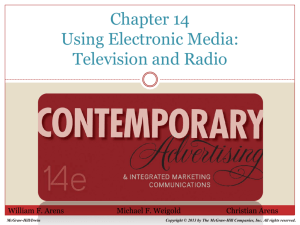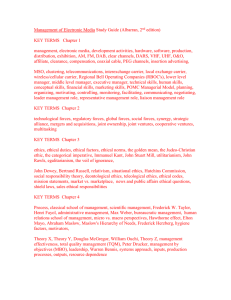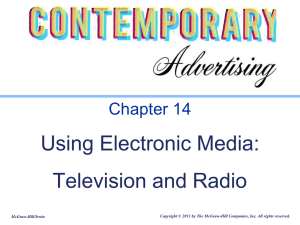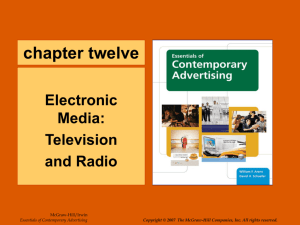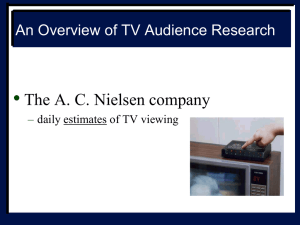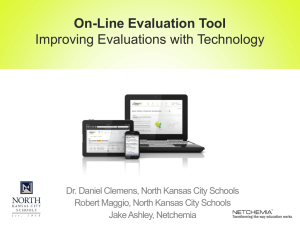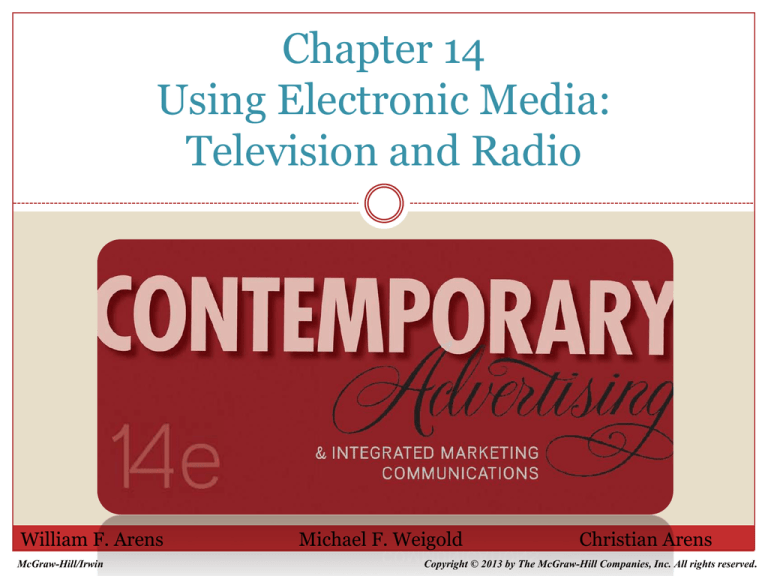
Chapter 14
Using Electronic Media:
Television and Radio
William F. Arens
McGraw-Hill/Irwin
Michael F. Weigold
Christian Arens
Copyright © 2013 by The McGraw-Hill Companies, Inc. All rights reserved.
Chapter Overview
Factors to evaluate when considering
radio & television in the creative mix
14-2
Chapter Objectives
Describe pros & cons
of broadcast TV as an
ad medium
Evaluate cable TV as an
advertising medium and
explain how it differs from
broadcast TV
Explain the process of
buying cable and broadcast
TV time
Evaluate the available types
of television advertising
Describe the process of TV
audience measurement
Discuss factors to consider
when buying TV time
Analyze pros and cons of
using radio in the creative
mix
Discuss factors to consider
when buying radio time
14-3
TV Viewers
Heaviest viewers
Middle income, high school grads and families
Increased viewing hours
Average American spends 4 hours/day watching TV
World wide, older women watch most
Average 36 hours/week
Broadcast vs. cable
Homes with cable watch less broadcast TV
Many channels causes audience fragmentation
DVD viewing has increased
14-4
Broadcast vs. Cable Viewer Characteristics
14-5
TV Audience Advertising Beliefs
How adult viewers rate various media
14-6
The Medium of Television
Broadcast TV
Cable TV
VHF and UHF
Many Stations, some PPV
Independent Stations
Special Interest Stations
Network Affiliates
Compete for Ads
14-7
Q. 1. What are the various TV audience
trends?
14-8
TV Audience Trends
Demographics
Cable households
DVD Rental
Viewing patterns
TV viewing hours
Audience fragmentation
14-9
Major Cable Networks
14-10
Q. 2. What are the pros and cons of TV
advertising?
14-11
The Medium of Television
Pros
Cons
Mass coverage
High production cost
Relatively low cost
High airtime cost
Some selectivity
Limited selectivity
Brevity
Impact
Creativity
Clutter
Prestige
Zipping and zapping
Social dominance
14-12
Q. 3. What are the pros and cons of Cable TV
advertising?
14-13
Cable TV Pros and Cons
Pros
Cons
Selectivity
Limited reach
Audience demographics
Fragmentation
Low cost
Quality
Flexibility
Zipping and zapping
Testability
14-14
Digital TV Advantages
Improved picture and sound
Efficiency through multicasting
Increased number of channels
Interactive video and data
14-15
Use of TV in IMC
Niche
medium
Leverage
Tool
TV
Cost
effective
Imparts
brand
meaning
14-16
Q. 4. How do advertisers buy time on TV?
14-17
Types of TV Advertising
Sponsorship
Spot ads
Syndication
Direct response
Local – LaVerge Beverage Depot
14-18
TV Ad Spending (Billions)
Network TV dominates, but is losing ground
14-19
Most Expensive 30-Second Spots
14-20
Types of TV Advertising
Prime time’s
most expensive
30-second
spots
http://www.frankwba
ker.com/2006_2007
_ad_rates.htm
How much for a 30second spot?
16-21
Insert ex. 16-7, p.
517
Ad cost per 30-sec
spot
Position = 2.9”horiz.,
1.5” vertical
Size = 4.6” TALL
Resolution: 300 dpi
14-21
TV vs. Magazine Cost Comparison
TV
Cost of Ad = $700,00.00
Reach = 4,000,000
Cost Per thousand (CPM) = 700,000/4,000,000/1000
Cost Per thousand (CPM) = $175.00
Magazine
Cost of Ad = $100,00.00
Reach = 200,000
Cost Per thousand (CPM) = 100,000/200,000/1000
Cost Per thousand (CPM) = $500.00
14-22
Network & Syndication Distribution
14-23
Why Direct Response Works
Consumers pay attention; respond immediately
Competitive advantage for brand managers
Sufficient time for brand differentiation
Results measurable and accountable
Ad campaign can pay for itself
Combines power of advertising, direct response, and
sales promotion
14-24
Defining Television Markets
DMA- designated market area for local stations
Columbus, Georgia designated market area
14-25
Q. 5. How do advertisers measure their
audience?
14-26
TV Audience Measurement
Rating
Services
Defining TV
Markets
Dayparts
Audience
Measures
Nielsen &
Others
Cable Ratings
14-27
TV Audience Measurement
Rating
Services
Defining TV
Markets
Nielsen & Others
Designated
Market Areas
Dayparts
Audience
Measures
Cable Ratings
14-28
Designated Market Area
Columbus, Georgia designated market area
14-29
TV Audience Measurement
Rating
Services
Defining TV
Markets
Nielsen &
Others
Designated
Market Areas
Cable Ratings
Dayparts
Audience
Measures
Daytime 9 a.m. – 4 p.m.
Early Fringe 4 – 5:30 p.m..
Early News 5 or 5:30 – 7:30 p.m.
Access 7:30 – 8 p.m.
Prime Time 8 – 11 p.m.
Late News 11 – 11:30 p.m.
Late Fringe 11:30 – 1 a.m.
14-30
TV Audience Measurement
Rating
Services
Defining TV
Markets
Nielsen &
Others
Designated
Market Areas
Dayparts
Audience
Measures
TV Households
Households
Using TV
Cable Ratings
Rating =
TVHH tuned to program
Total TVHH in area
Program
Rating
Audience
Share
14-31
Defining Television Markets
Dayparts
14-32
TV Audience Measurement
Audience Measures
TV
Households
TVHH
Households
Using TV
HUT
Program Rating
TVHH tuned to program
Total TVHH in area
Audience Share
# of viewers
HUT
14-33
Buying TV Time
Gross Rating Points
Cost per Point
Cost per Thousand
GRP =
CPP
=
CPM =
Reach (avg rating) ×
Frequency
Cost
Rating
Cost
Thousands of People
14-34
Buying TV Time
1. Determine
program
availability
2. Analyze
program
efficiency
3. Negotiate
price
4. Determine
reach and
frequency
5. Sign
broadcast
contracts
6. Review
performance
affidavits
14-35
The Medium of Radio
Who uses radio?
93% of U.S adults listen
each week
72% of U.S. adults listen
every day
Average time is 2.5 hours
per day
Radio’s reach exceeds
other media
14-36
Use of Radio in IMC
Involves
people
Favors
integrated
marketing
Target
demographic
group
Establishes
intimate
relationship
Maintain
strategic
consistency
Stretch
media dollars
14-37
Most Popular Program Formats
14-38
Q. 6. What are the pros and cons of Radio
advertising?
14-39
Pros and Cons of Radio Ads
Pros
Cons
Reach & frequency
Limitations of sound
Selectivity
Segmented audiences
Cost efficiency
Short-lived, half heard
Testability
Clutter
Timeliness & immediacy
Local relevance
Creative flexibility
14-40
Mini-network Programming
Each network targets a specific demographic group
14-41
Q. 7. How do Radio advertisers buy time?
14-42
Buying Radio Time
Network
Spot
Local
Radio stations
can increase
market share
with special
programming
14-43
Key Radio Terms
Cumes
Average quarterhour audiences
Dayparts
Morning drive 6 a.m. – 10 a.m.
Daytime 10 p.m. – 3 p.m.
Afternoon drive 3 p.m. – 7 p.m.
Nighttime 7 p.m. – midnight
All night Midnight – 6 a.m.
14-44
Ratings Based on Dayparts
Run-of-Station (ROS)
Total Audience Plan (TAP)
Average QuarterHour (AQH)
Gross Rating Points
(GRP)
Cume Estimates
AQH Rating =
GRP
AQH Persons × 100
Population
= AQH Rating × No. of Spots
Reach Potential × 100
Cume Rating =
Population
14-45
Satellite Radio
Sirius & XM are major players
Over 16 million listeners
Many program choices
Exclusive programming
14-46
Preparing a Radio Schedule
1.
2.
3.
4.
5.
6.
7.
ID stations with greatest concentration (cume) of target
audience
ID stations whose format offers highest concentration
of buyers
Determine which dayparts offer the most potential
buyers
Construct schedule with strong mix of best times
Assess proposed buy in terms of reach and frequency
Determine cost/1000 target people
Negotiate and place the buy
14-47

